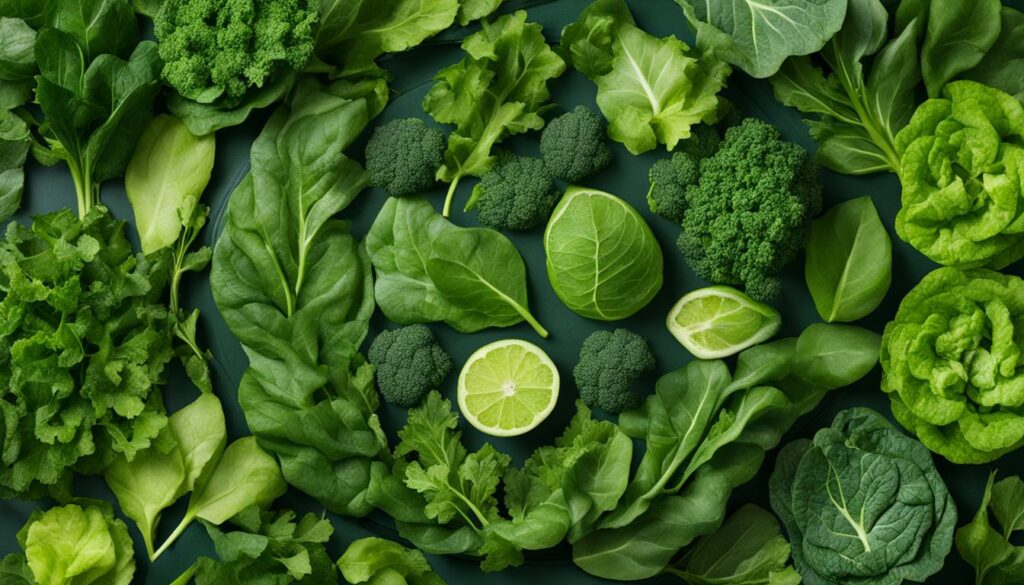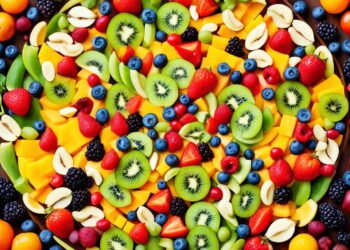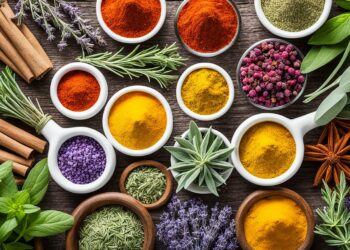Endive, scientifically known as chicorum endivia, is a leafy vegetable that belongs to the chicory family. There are different varieties of endive, including Belgian endive and curly endive, each with its own appearance and flavor.
Endives are packed with health benefits, being a good source of vitamins A and K, as well as dietary fiber. They also contain important minerals like calcium and potassium.
The flavor compounds present in endives, such as chicory intybin, have been linked to potential health benefits, including aiding digestion, supporting gut health, and providing antioxidants.
Key Takeaways:
- Endive is a nutritious leafy vegetable packed with vitamins and minerals.
- It is a good source of vitamins A and K, as well as dietary fiber, calcium, and potassium.
- The flavor compounds in endive offer potential health benefits, including aiding digestion and providing antioxidants.
- Endive comes in different varieties, including Belgian endive and curly endive, each with its own unique appearance and flavor.
- Endive can be enjoyed raw in salads or cooked to develop a silky texture and soften its flavor.
Different Varieties of Endive
When it comes to endive, there are two main varieties that stand out: Belgian endive and curly endive. Each variety has its own distinct characteristics, allowing for a diverse range of culinary possibilities.
Belgian Endive
Belgian endive, also known as witloof or white gold, is a popular variety with a unique appearance. It is characterized by tightly packed leaves that form an elongated, cylindrical shape. Belgian endive has a pale yellow or cream-colored exterior, and its leaves are often tender and crispy.
“Belgian endive has a pleasant bitterness and delicate flavor that pairs well with a variety of dishes,” says Chef Julia Smith.
Additionally, Belgian endive can also come with red leaves, which add a vibrant pop of color to any dish. The red leaves, however, tend to be slightly more bitter in flavor compared to the lighter leaves.
Curly Endive
Curly endive, also known as frisée, is characterized by its curly and frilly leaves, which resemble arugula leaves. It has a vibrant green color and a slightly bitter taste, adding a pleasant contrast to a variety of dishes.
Curly endive is often used in salads, providing a unique texture and a touch of bitterness. Its robust flavor can add depth to salads and complement other ingredients.
Comparison Table: Belgian Endive vs. Curly Endive
| Attributes | Belgian Endive | Curly Endive |
|---|---|---|
| Appearance | Light cream color with tightly packed, elongated leaves | Vibrant green with frilly, curly leaves |
| Flavor | Delicate with a pleasant bitterness | Slightly bitter and robust |
| Uses | Raw in salads, cooked in various dishes | Raw in salads |
Whether you choose Belgian endive for its delicate flavor or curly endive for its robust bitterness, both varieties offer a unique culinary experience. These versatile endive varieties can be used in a variety of dishes to elevate flavors and add visual appeal.
Health Benefits of Endive
Endives are highly nutritious and offer numerous health benefits. They are a good source of vitamins A and K, which are important for vision, bone health, and disease prevention. Endives also contain dietary fiber, calcium, potassium, and other minerals.
The flavor compounds present in endives, such as chicory intybin, have been linked to potential health benefits, including aiding digestion, supporting gut health, and providing antioxidants.
Here is a breakdown of the nutrition facts and health benefits of endive:
| Nutrient | Nutrition Value per 100g |
|---|---|
| Calories | 17 |
| Carbohydrates | 3.35g |
| Protein | 0.9g |
| Fat | 0.2g |
| Vitamin A | 2945 IU |
| Vitamin K | 231.5 mcg |
| Calcium | 52mg |
| Potassium | 314mg |
| Fiber | 3.1g |
Health Benefits at a Glance:
- Helps improve vision and maintain eye health with its high vitamin A content.
- Promotes bone health and reduces the risk of bone-related diseases due to its vitamin K content.
- Aids digestion with the presence of chicory intybin, supporting healthy gut function.
- Provides antioxidants that help combat oxidative stress and protect cells from damage.
- Contributes to maintaining a healthy weight with its low calorie and high fiber content.
Endive is a versatile and nutritious leafy vegetable that offers numerous health benefits. Whether consumed raw in salads or cooked to enhance its flavors, endive can be a valuable addition to your diet, promoting overall wellness and vitality.
Note: The nutrition values provided are approximate and may vary slightly depending on the specific variety of endive and its growing conditions.
Cooking with Endive
Endive is a versatile leafy vegetable that can be enjoyed in various ways, whether raw or cooked. Here are some ways to incorporate endive into your meals:
1. Endive Salad
One of the simplest and most refreshing ways to enjoy endive is in a salad. The slightly bitter flavor of endive pairs well with other ingredients like sweet fruits, tangy cheeses, and creamy dressings.
Try making an Endive Apple Salad by combining sliced endive, crisp apples, crumbled blue cheese, and a light vinaigrette dressing. The combination of textures and flavors creates a delightful salad that is both healthy and satisfying.
2. Grilled or Sautéed Endive
Grilling or sautéing endive can help reduce its bitterness and bring out its natural sweetness. Cut endive into halves or quarters, drizzle with olive oil, and season with salt and pepper.
Grill or sauté over medium heat until the leaves start to soften and caramelize. This method adds a smoky flavor and develops a silky texture, making it a great addition to any dish.
3. Warm Endive Salads
Endive can also be used in warm salads, adding a unique twist to traditional recipes. Sauté endive with bacon, onions, and garlic for a flavorful side dish.
You can also braise endives by slowly cooking them in a liquid, such as broth or wine, along with added sweetness from honey or balsamic vinegar. The braising process softens the endive leaves, making them tender and delicious.
4. Endive Recipes
There are countless recipes that feature endive as a star ingredient. From appetizers to main courses, endive adds a touch of elegance and flavor to any dish. For a unique appetizer, try Grilled Belgian Endive with Balsamic Butter.
This recipe combines the smoky flavor of grilled endive with a tangy balsamic butter sauce, resulting in a delightful and visually appealing dish.
| Recipe | Description |
|---|---|
| Endive Apple Salad | A refreshing salad combining endive, crisp apples, crumbled blue cheese, and a light vinaigrette dressing. |
| Grilled Belgian Endive with Balsamic Butter | Grilled endive drizzled with a tangy balsamic butter sauce, creating a flavorful and visually appealing appetizer. |
| Warm Endive and Bacon Salad | Sautéed endive with bacon, onions, and garlic, resulting in a warm and flavorful side dish. |
Whether you prefer the crisp texture of raw endive in salads or the softer texture that comes from cooking, there are endless possibilities for incorporating endive into your culinary creations. Experiment with different cooking methods and recipes to discover your favorite way to enjoy this versatile vegetable.
Prepping and Storing Endive
Properly prepping and storing endive is essential to ensure its freshness and quality. Follow these simple steps to make the most of your endives:
- Cleaning: Endives require minimal cleaning. Simply rinse them under cold water to remove any dirt or debris. Pat them dry gently using a clean kitchen towel or paper towels.
- Prepping: Endives can be prepped just before use to avoid wilting. Trim the stem end with a sharp knife and separate the leaves carefully.
- Storing: To store endive, place them in a ventilated plastic bag or wrap them loosely in a damp paper towel. This will help maintain their crispness. Store the bag or bundle in the refrigerator, preferably in the crisper drawer.
- Storage Duration: Endives can typically last up to 14 days when stored properly. However, it is best to use them within a week for optimal flavor and texture.
When using stored endives, inspect them carefully and remove any browned or wilted outer leaves before reaching the fresh, unblemished inner leaves.
Pro Tip
For longer storage, blanch the endive leaves in boiling water for 1-2 minutes, then cool them quickly in ice water. Drain well and pat dry before storing in airtight containers or freezer-safe bags in the freezer. Frozen endive leaves can be used in soups, stews, or other cooked dishes.
By following these steps, you can ensure that your endives stay fresh and delicious for longer, allowing you to enjoy their unique flavor and texture in various culinary creations.
| Prepping and Storing Endive Tips | Benefits |
|---|---|
| Minimal cleaning needed | Ensures freshness |
| Prep just before use | Avoids wilting |
| Store in ventilated plastic bags | Maintains crispness |
| Remove browned or wilted leaves | Retains quality |
Benefits of Other Salad Greens
Aside from endive, there are several other salad greens that offer a range of health benefits. Incorporating these greens into your diet can add variety and nutrition to your meals. Let’s take a closer look at three popular salad greens: bibb lettuce, watercress, and mesclun.
Bibb Lettuce
Bibb lettuce is a mild and sweet salad green with a soft buttery texture. It is often used as a base for salads or as a wrap for fillings. This versatile green is not only delicious but also packed with nutrients.
Bibb lettuce is a good source of vitamin A, which is essential for vision health and a strong immune system. It also contains folate, a B vitamin that supports cell growth and development.
Watercress
Watercress is a peppery and slightly bitter salad green that adds a unique flavor to dishes. This green leafy vegetable is not only low in calories but also rich in vitamins and minerals.
Watercress is high in vitamins A and C, both of which are powerful antioxidants that help protect the body against free radicals. Additionally, watercress has potential anti-inflammatory properties that may promote overall health and well-being.
Mesclun
Mesclun is a mix of various salad leaves, offering a diverse blend of flavors and textures. It typically includes arugula, frisée, romaine, and mâche, among other leafy greens.
Mesclun is not only visually appealing but also highly nutritious. It is rich in vitamin A, which is essential for healthy skin and vision. It also contains vitamin C, an antioxidant that supports immune function, and folate, which is important for cell growth and development.
By incorporating these salad greens into your meals, you can enjoy a wide range of flavors and maximize your nutrient intake. Whether you’re looking for a mild and buttery base or a peppery and nutrient-rich addition to your salad, bibb lettuce, watercress, and mesclun are excellent choices.

Facts About Chicory Root
Chicory root is the root of a perennial Mediterranean plant and is rich in fiber and other important nutrients. It is known for its natural laxative effects and contains inulin, a prebiotic that promotes gut health.
Chicory root may also aid in diabetes treatment, help fight inflammatory arthritis, aid detoxification and weight loss, and improve skin barrier function. It can be consumed daily but should be consumed in moderation to avoid complications.
Chicory Root Benefits
Chicory root offers a range of health benefits due to its nutrient content and therapeutic properties. Here are some key benefits:
- Gut Health: Chicory root contains inulin, a type of dietary fiber that acts as a prebiotic, nourishing the beneficial bacteria in the gut. This promotes a healthy digestive system and improves overall gut health.
- Diabetes Management: The inulin in chicory root has been shown to have blood sugar-lowering effects, making it beneficial for individuals with diabetes. It helps regulate blood glucose levels and improves insulin sensitivity.
- Anti-Inflammatory Effects: Certain compounds found in chicory root, such as chicoric acid, have anti-inflammatory properties. They help reduce inflammation in the body, making chicory root potentially beneficial for individuals with inflammatory conditions like arthritis.
- Detoxification and Weight Loss: Chicory root acts as a natural diuretic and aids in the detoxification process. It helps eliminate toxins from the body and can assist in weight loss efforts by promoting satiety and reducing calorie intake.
- Improved Skin Health: Chicory root extract has been found to improve skin barrier function, helping to retain moisture and protect against external irritants. It may contribute to healthier, more radiant skin.
It’s important to note that while chicory root offers numerous benefits, it should be consumed in moderation. Excessive consumption may lead to digestive issues such as bloating or gas.
| Chicory Root Benefits | How It Helps |
|---|---|
| Promotes Gut Health | Contains inulin, a prebiotic that nourishes beneficial gut bacteria |
| Aids in Diabetes Management | Helps regulate blood sugar levels and improves insulin sensitivity |
| Anti-Inflammatory Effects | Reduces inflammation in the body, potentially benefiting individuals with arthritis |
| Detoxification and Weight Loss | Acts as a natural diuretic, aids in detoxification, and promotes satiety |
| Improved Skin Health | Enhances skin barrier function, retains moisture, and protects against irritants |
Conclusion
Endive, a versatile and nutritious leafy vegetable, offers a plethora of health benefits. Rich in vitamins, minerals, fiber, and antioxidants, endive is a valuable addition to a healthy diet.
Whether you prefer to enjoy it raw in salads or cooked to create unique flavors and textures, incorporating endive into your meals is a delicious and nutritious choice.
With its impressive nutritional profile, endive provides essential vitamins and minerals that support overall well-being. Vitamins A and K promote healthy vision and bone health, while dietary fiber aids in digestion.
Additionally, endive’s natural compounds like chicory intybin offer potential benefits for gut health and provide valuable antioxidant properties.
Unlock the power of greens and reap the benefits of endive’s health properties today. Experiment with delectable endive recipes or add it to your favorite dishes for an extra boost of nutrition.
Whether you savor its crispness in a refreshing salad or savor its silky texture in a cooked preparation, endive is a delightful and nutritious choice to embrace.
FAQ
What are the health benefits of endive?
Endive is packed with health benefits. It is a good source of vitamins A and K, as well as dietary fiber. It also contains important minerals like calcium and potassium. The flavor compounds in endive, such as chicory intybin, have been linked to potential health benefits, including aiding digestion, supporting gut health, and providing antioxidants.
What are the different varieties of endive?
There are two main varieties of endive – Belgian endive and curly endive. Belgian endive is light in color with closely bunched leaves, while curly endive resembles arugula leaves with frilled edges. Belgian endive can also come with red leaves, which tend to be more bitter in flavor compared to the lighter leaves.
How can endive be cooked?
Endive can be enjoyed raw in salads or cooked to develop a silky texture and soften its flavor. It can be grilled, sautéed, or used in warm salads.
Sautéing or grilling endive halves or quarters with a drizzle of olive oil helps reduce bitterness and develop a richer flavor. Braising endives involves cooking them slowly in a liquid, often with added sweetness like honey or balsamic vinegar.
How should endive be stored?
Endives should be stored in ventilated plastic bags in the refrigerator and can last up to 14 days. When storing, remove any browned outer leaves until reaching the unblemished inner leaves, which remain fresh.
What are some other salad greens similar to endive?
Other salad greens like bibb lettuce, watercress, and mesclun are also low in calories and high in nutrients. Bibb lettuce is mild and sweet with a soft buttery texture and is a good source of vitamin A and folate.
Watercress is peppery and slightly bitter, high in vitamins A and C, and has potential anti-inflammatory properties. Mesclun is a mix of various salad leaves, including arugula, frisée, romaine, and mâche, and is high in vitamin A, vitamin C, and folate.
What are the benefits of consuming chicory root?
Chicory root is rich in fiber and other important nutrients. It is known for its natural laxative effects and contains inulin, a prebiotic that promotes gut health.
Chicory root may also aid in diabetes treatment, help fight inflammatory arthritis, aid detoxification and weight loss, and improve skin barrier function. It can be consumed daily but should be consumed in moderation to avoid complications.
What are the health benefits of endive?
Endive is a versatile and nutritious leafy vegetable that offers numerous health benefits. From vitamins and minerals to fiber and antioxidants, endive is a valuable addition to a healthy diet. Whether enjoyed raw in salads or cooked to develop unique flavors and textures, endive can be a delicious and nutritious addition to your meals.








